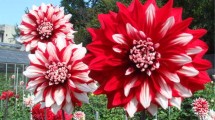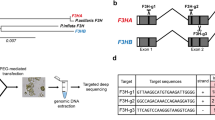Abstract
Garden dahlias (Dahlia variabilis) are autoallooctoploids with redundant genes producing wide color variations in flowers. There are no pure white dahlia cultivars, despite its long breeding history. However, the white areas of bicolor flower petals appear to be pure white. The objective of this experiment was to elucidate the mechanism by which the pure white color is expressed in the petals of some bicolor cultivars. A pigment analysis showed that no flavonoid derivatives were detected in the white areas of petals in a star-type cultivar ‘Yuino’ and the two seedling cultivars ‘OriW1’ and ‘OriW2’ borne from a red-white bicolor cultivar, ‘Orihime’, indicating that their white areas are pure white. Semi-quantitative RT-PCR showed that in the pure white areas, transcripts of two chalcone synthases (CHS), DvCHS1 and DvCHS2 which share 69% nucleotide similarity with each other, were barely detected. Premature mRNA of DvCHS1 and DvCHS2 were detected, indicating that these two CHS genes are silenced post-transcriptionally. RNA gel blot analysis revealed that small interfering RNAs (siRNAs) derived from CHSs were produced in these pure white areas. By high-throughput sequence analysis of small RNAs in the pure white areas with no mismatch acceptance, small RNAs were mapped to two alleles of DvCHS1 and two alleles of DvCHS2 expressed in ‘Yuino’ petals. Therefore, we concluded that simultaneous siRNA-mediated post-transcriptional gene silencing of redundant CHS genes results in the appearance of pure white color in dahlias.







Similar content being viewed by others
Abbreviations
- 3GT:
-
Anthocyanidin 3-glucosyltransferase
- ANS:
-
Anthocyanidin synthase
- bHLH:
-
Basic helix-loop-helix
- CHI:
-
Chalcone isomerase
- CHS:
-
Chalcone synthase
- DFR:
-
Dihydroflavonol 4-reductase
- F3H:
-
Flavanone 3-hydroxylase
- FLS:
-
Flavonol synthase
- FNS:
-
Flavone synthase
- HPLC:
-
High-performance liquid chromatography
- ORF:
-
Open-reading frame
- PTGS:
-
Post-transcriptional gene silencing
- siRNA:
-
Small interfering RNA
- SNPs:
-
Single nucleotide polymorphisms
- TLC:
-
Thin layer chromatography
- TGS:
-
Transcriptional gene silencing
- WDR:
-
WD40 repeats
References
Bate-Smith EC, Swain T, Nördstrom CG (1955) Chemistry and inheritance of flower colour in the Dahlia. Nature 176:1016–1018
De Paoli E, Dorantes-Acosta A, Jixian Z, Accerbi M, Jeong DH, Sunhee P, Meyers BC, Jorgensen RA, Green PJ (2009) Distinct extremely abundant siRNAs associated with cosuppression in petunia. RNA 15:1965–1970
Ferrer JL, Jez JM, Bowman ME, Dixon RA, Noel JP (1999) Structure of chalcone synthase and the molecular basis of plant polyketide biosynthesis. Nat Struct Biol 6:775–784
Fukusaki EI, Kawasaki K, Kajiyama S, An CI, Suzuki K, Tanaka Y, Kobayashi A (2004) Flower color modulations of Torenia hybrida by downregulation of chalcone synthase genes with RNA interference. J Biotechnol 111:229–240
Gatt M, Ding H, Hammett K, Murray B (1998) Polyploidy and evolution in wild and cultivated Dahlia species. Ann Bot 81:647–656
Ghildiyal M, Zamore PD (2009) Small silencing RNAs: an expanding universe. Nat Rev Gen 10:94–108
Hamilton AJ, Baulcombe DC (1999) A species of small antisense RNA in posttranscriptional gene silencing in plants. Science 286:950–952
Harborne JB (1984) Phytochemical methods, 2nd edn. Chapman and Hall, London
Hemleben V, Dressel A, Epping B, Lukačin R, Martens S, Austin MB (2004) Characterization and structural features of a chalcone synthase mutation in a white-flowering line of Matthiola incana R. Br. (Brassicaceae). Plant Mol Biol 55:455–465
Hichri I, Barrieu F, Bogs J, Kappel C, Delrot S, Lauvergeat V (2011) Recent advances in the transcriptional regulation of the flavonoid biosynthetic pathway. J Exp Bot. doi:10.1093/jxb/erq442
Hoshino A, Park KI, Iida S (2009) Identification of r mutations conferring white flowers in the Japanese morning glory (Ipomoea nil). J Plant Res 122:215–222
Jiang CZ, Chen JC, Reid M (2011) Virus-induced gene silencing in ornamental plants. Methods Mol Biol 744:81–96
Koseki M, Goto K, Masuta C, Kanazawa A (2005) The star-type color pattern in Petunia hybrida ‘Red Star’ flowers is induced by sequence-specific degradation of chalcone synthase RNA. Plant Cell Physiol 46:1879–1883
Kurauchi T, Matsumoto T, Taneda A, Sano T, Senda M (2009) Endogenous short interfering RNAs of chalcone synthase genes associated with inhibition of seed coat pigmentation in soybean. Breed Sci 59:419–426
Lawrence WJC (1929) The genetics and cytology of Dahlia species. J Genet 21:125–159
Lawrence RJ, Pikaard CS (2003) Transgene-induced RNA interference: a strategy for overcoming gene redundancy in polyploids to generate loss-of-function mutations. Plant J 36:114–121
Ma LQ, Pang XB, Shen HY, Pu GB, Wang HH, Lei CY, Wang H, Li GF, Liu BY, Ye HC (2009) A novel type III polyketide synthase encoded by a three-intron gene from Polygonum cuspidatum. Planta 229:457–469
Martin C, Carpenter R, Sommer H, Saedler H, Coen ES (1985) Molecular analysis of instability in flower pigmentation of Antirrhinum majus, following isolation of the pallida locus by transposon tagging. EMBO J 4:1625–1630
Mato M, Onozaki T, Ozeki Y, Higeta D, Itoh Y, Yoshimoto Y, Ikeda H, Yoshida H, Shibata M (2000) Flavonoid biosynthesis in white-flowered Sim carnations (Dianthus caryophyllus). Sci Hortic 84:333–347
McClaren M (2009) Dahlia: history and species. In: McClaren B (ed) Encyclopedia of dahlias. Timber Press, Portland, pp 161–166
Metzlaff M, O’Dell M, Cluster PD, Flavell RB (1997) RNA-mediated RNA degradation and chalcone synthase A silencing in Petunia. Cell 88:845–854
Morita Y, Saitoh M, Hoshino A, Nitasaka E, Iida S (2006) Isolation of cDNAs for R2R3-MYB, bHLH and WDR transcriptional regulators and identification of c and ca mutations conferring white flowers in the Japanese morning glory. Plant Cell Physiol 47:457–470
Nakatsuka T, Nishihara M, Mishiba K, Yamamura S (2005) Two different mutations are involved in the formation of white-flowered gentian plants. Plant Sci 169:949–958
Nakatsuka T, Mishiba KI, Kubota A, Abe Y, Yamamura S, Nakamura N, Tanaka Y, Nishihara M (2010) Genetic engineering of novel flower colour by suppression of anthocyanin modification genes in gentian. J Plant Physiol 167:231–237
Napoli C, Lemieux C, Jorgensen R (1990) Introduction of a chimeric chalcone synthase gene into petunia results in reversible co-suppression of homologous genes in trans. Plant Cell 2:279–289
Nesi N, Debeaujon I, Jond C, Pelletier G, Caboche M, Lepiniec L (2000) The TT8 gene encodes a basic helix-loop-helix domain protein required for expression of DFR and BAN genes in Arabidopsis siliques. Plant Cell 12:1863–1878
Nordström CG, Swain T (1956) The flavonoid glycosides of Dahlia variabilis. II. Glycosides of yellow varieties Pius IX and Coton. Arch Biochem Biophys 60:329–344
Nordström CG, Swain T (1958) The flavonoid glycosides of Dahlia variabilis. III. Glycosides from white varieties. Arch Biochem Biophys 73:220–223
Ohno S, Hosokawa M, Hoshino A, Kitamura Y, Morita M, Park KI, Nakashima A, Deguchi A, Tatsuzawa F, Doi M, Iida S, Yazawa S (2011) bHLH transcription factor, DvIVS, is involved in regulation of anthocyanin synthesis in dahlia (Dahlia variabilis). J Exp Bot (in press)
Onozaki T, Mato M, Shibata M, Ikeda H (1999) Differences in flower color and pigment composition among white carnation (Dianthus caryophyllus L.) cultivars. Sci Hortic 82:103–111
Park KI, Choi JD, Hoshino A, Morita Y, Iida S (2004) An intragenic tandem duplication in a transcriptional regulatory gene for anthocyanin biosynthesis confers pale-colored flowers and seeds with fine spots in Ipomoea tricolor. Plant J 38:840–849
Park KI, Ishikawa N, Morita Y, Choi JD, Hoshino A, Iida S (2007) A bHLH regulatory gene in the common morning glory, Ipomoea purpurea, controls anthocyanin biosynthesis in flowers, proanthocyanidin and phytomelanin pigmentation in seeds, and seed trichome formation. Plant J 49:641–654
Quattrocchio F, Wing JF, Leppen HTC, Mol JNM, Koes RE (1993) Regulatory genes controlling anthocyanin pigmentation are functionally conserved among plant species and have distinct sets of target genes. Plant Cell 5:1497–1512
Saito N, Ishizuka K, Osawa Y (1970) Paper-chromatographic identification of flavonoids from a scarlet-flowering dahlia and crystallization of pelargonidin and butein. Bot Mag Tokyo 83:229–232
Senda M, Jumonji A, Yumoto S, Ishikawa R, Harada T, Niizeki M, Akada S (2002) Analysis of the duplicated CHS1 gene related to the suppression of the seed coat pigmentation in yellow soybeans. Theor Appl Genet 104:1086–1091
Spelt C, Quattrocchio F, Mol JNM, Koes R (2000) anthocyanin1 of Petunia encodes a basic helix-loop-helix protein that directly activates transcription of structural anthocyanin genes. Plant Cell 12:1619–1631
Spelt C, Quattrocchio F, Mol J, Koes R (2002) ANTHOCYANIN1 of petunia controls pigment synthesis, vacuolar pH, and seed coat development by genetically distinct mechanisms. Plant Cell 14:2121–2135
Spribille R, Forkmann G (1982) Genetic control of chalcone synthase activity in flowers of Antirrhinum majus. Phytochemistry 21:2231–2234
Stam M (1997) Post-transcriptional silencing of flower pigmentation genes in Petunia hybrida by (trans)gene repeats. PhD thesis, Vrije Universiteit
Suzuki H, Nakayama T, Yonekura-Sakakibara K, Fukui Y, Nakamura N, Yamaguchi MA, Tanaka Y, Kusumi T, Nishino T (2002) cDNA cloning, heterologous expressions, and functional characterization of malonyl-coenzyme A:anthocyanidin 3-O-glucoside-6′-O-malonyltransferase from dahlia flowers. Plant Physiol 130:2142–2151
Tuteja JH, Zabala G, Varala K, Hudson M, Vodkin LO (2009) Endogenous, tissue-specific short interfering RNAs silence the chalcone synthase gene family in Glycine max seed coats. Plant Cell 21:3063–3077
Van Der Krol AR, Mur LA, Beld M, Mol JNM, Stuitje AR (1990) Flavonoid genes in petunia: addition of a limited number of gene copies may lead to a suppression of gene expression. Plant Cell 2:291–299
Zheng D, Schröder G, Schröder J, Hrazdina G (2001) Molecular and biochemical characterization of three aromatic polyketide synthase genes from Rubus idaeus. Plant Mol Biol 46:1–15
Author information
Authors and Affiliations
Corresponding author
Electronic supplementary material
Below is the link to the electronic supplementary material.
Rights and permissions
About this article
Cite this article
Ohno, S., Hosokawa, M., Kojima, M. et al. Simultaneous post-transcriptional gene silencing of two different chalcone synthase genes resulting in pure white flowers in the octoploid dahlia. Planta 234, 945–958 (2011). https://doi.org/10.1007/s00425-011-1456-2
Received:
Accepted:
Published:
Issue Date:
DOI: https://doi.org/10.1007/s00425-011-1456-2




